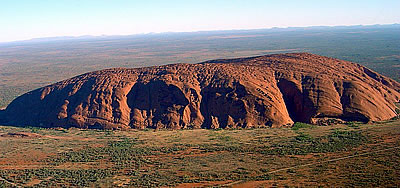Uluru, also known as Ayers Rock, is one of the few remnants of an ocean floor that occupied the center of Australia around 500 million years ago.
The rock, which is composed of sandstone conglomerate, is 3km (2mi) long and 348m (1,142ft) high. It rises dramatically above a vast plain.
Much of the rock's bulk lies below ground - some geologists estimate the rock reaches 6km (3.75mi) down into the Earth's crust.
 Uluru has defied the forces of erosion for hundreds of thousands of years, as the center of Australia has been transformed from a lush, fertile landscape to a desert.
Uluru has defied the forces of erosion for hundreds of thousands of years, as the center of Australia has been transformed from a lush, fertile landscape to a desert.
Gradual upheavals and movements of the Earth's crust have upturned the rock's formerly horizontal layers; weathering has fashioned their exposed edges into ridges and grooves.
A Sacred Site
Around the rock's perimeter, a distance of more than 8km (5mi), are numerous caves and hollows sacred to Aborigines.
Many sacred paintings relating to the Dreamtime, the time when all things began, decorate the caves.
Every individual feature of Ayers Rock - every crack, indentation or a lump, has a meaning to the local Aborigines, the Yankunitjatjara and the Pitjantjatjara
The Brain is a shallow depression ridged and furrowed just as a brain is.
The Sound Shell, a smoother cavity, lives up to its name when the wind blows.
A cave at the base where erosion has scooped out a long narrow hollow from the sandstone is shaped like a huge breaking wave that appears to be about to crash to the ground at any moment.